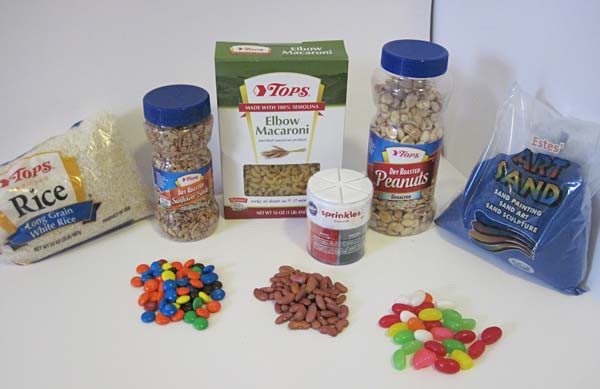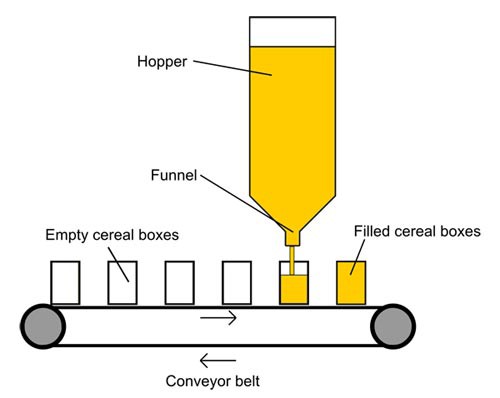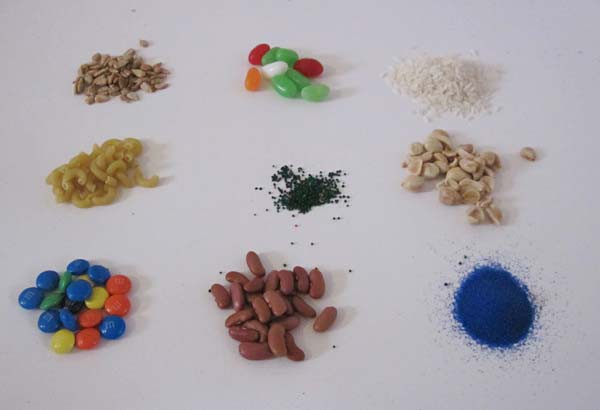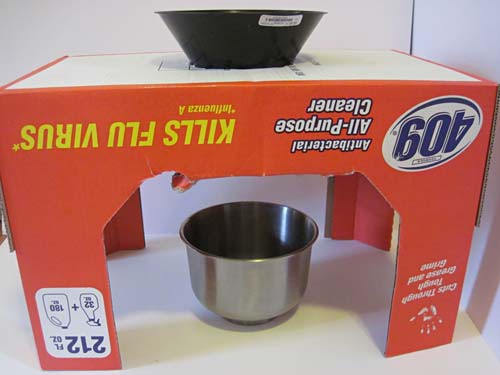Abstract
What do sand, Skittles, and cereal have in common? They are all granular materials, which means they are made up of solid particles, but they can actually flow like liquid! Imagine pouring the sand out of a bucket or pouring the cereal out of a box— a lot like pouring water, right? In this physics science project, you will investigate how the size of granular materials affect how they flow.Summary
Ben Finio, Ph.D., Science Buddies
This science project idea is based on a project submitted to Science Buddies by Natalia Alvarez of Northwestern University.
- LEGO® is a registered trademark of The LEGO Group.
- M&M's® is a registered trademark of Mars, Incorporated.

Objective
Determine how the size of different granular materials affects their mass flow rate through a funnel.
Introduction
You may have learned that there are three types of matter: solids, liquids, and gases. For instance, rocks are solid, water is a liquid, and air is a gas. What about something like sand? You can stand on sand like a solid, but if you are making a sand castle, you can pour it out of a bucket like a liquid. Solid matter (like sand) that is made up of many individual small particles is called a granular material, and the individual particles are called grains. Granular materials can range in size from very small powders like sugar and flour that you use in your kitchen, to very large objects like rocks and boulders. Note that the word "grain" does not just refer to things you would traditionally call grains, like sand or rice; it can be any object or particle in a granular material. In order for a granular material to behave like a liquid, there must be many, many grains close together. For example, a single boulder rolling down a hill is not acting like a liquid; but thousands of rocks, boulders, and dirt particles flowing down a hill during a landslide do behave like a liquid. Similarly, a single piece of cereal does not act like a liquid, but your cereal flows like a liquid when you pour a bunch of it out of the box and into a bowl. Most of the granular materials you encounter in everyday life are food products and not big things like boulders. Figure 1 shows some examples of everyday granular materials.
 Image Credit: Ben Finio, Science Buddies / Science Buddies
Image Credit: Ben Finio, Science Buddies / Science Buddies
Figure 1. Examples of different granular materials that can be found at local grocery or arts and crafts stores.
When granular materials flow like a liquid, it is called granular flow. Understanding granular flow is very important, especially for many industries that need to put things like candy, cereal, or pills into bottles or bags. In these factories, granular materials are usually stored in a large container called a hopper. At the bottom of the hopper there is a funnel. Engineers need to know exactly how fast material flows out of the funnel so they can put the right amount in each container (imagine how upset you would be if you opened a new box of cereal and it was only half-full!). A drawing of this process is shown in Figure 2. To determine the exact amount of material that flows out of the funnel, engineers need to determine the mass flow rate. Mass flow rate measures how much material leaves the funnel per unit time, and is usually measured in kilograms per second (kg/s). It can also be measured in grams per second (g/s).
Note: In some factories, there is a step in the middle; instead of flowing directly into a container, the material (such as cereal) first falls onto a scale. When the scale reaches a certain weight, the material is then dumped into the box. Engineers still need to know the mass flow rate in this case, so they know approximately how long to open the funnel each time.
 Image Credit: Ben Finio, Science Buddies / Science Buddies
Image Credit: Ben Finio, Science Buddies / Science Buddies
Figure 2. A drawing of a factory setup that pours an equal amount of cereal into every box. A large hopper contains a large quantity of cereal, and a certain amount of cereal must be dispensed into individual boxes. By determining the mass flow rate of cereal leaving the funnel, engineers and factory workers know exactly how long to put each box under the funnel (remember though the cereal first falls onto a scale in some cases, engineers still need to know the mass flow rate).
Many different things can affect the mass flow rate of a granular material. For example, a spherical candy might flow at a different speed than an irregularly shaped cereal, and both of these things might flow at different speeds than rough pieces of pasta. In this physics science project, you will do an experiment to test the mass flow rate of different sized granular materials through a funnel. You will then analyze your results to see if there is a correlation between the size of the granular materials and their mass flow rate. Figure 3 shows a close-up view of different granular materials from Figure 1. To come up with a hypothesis, think about how small grains can pack together in the hopper compared to much larger grains (in other words, the density of the grains as a group, including air spaces), and how smaller grains roll through the funnel compared to larger grains. How quickly do you think the different granular materials will flow through a funnel?
 Image Credit: Ben Finio, Science Buddies / Science Buddies
Image Credit: Ben Finio, Science Buddies / Science Buddies
Figure 3. A close-up view of nine different granular materials. Notice how they have different shapes and sizes.
Terms and Concepts
- Matter
- Grain
- Granular material
- Granular flow
- Hopper
- Funnel
- Mass flow rate
- Density
Questions
- Can you make a list of granular materials? How many of them do you encounter in everyday life?
- What is mass flow rate? Why is it important?
- What physical characteristics of granular materials do you think will affect their flow rate? What do you think will make a material flow faster or slower? For example, will large particles flow faster than small particles? Will smooth materials flow faster than rough materials?
Bibliography
- Wikipedia contributors. (February 19, 2013). Granular Materials. Retrieved April 17, 2013.
- Lois, Gregg. (n.d.). Granular Materials. Retrieved April 17, 2013.
- Kids.Net.Au. (n.d.). Density. Retrieved October 7, 2013.
For help creating graphs, try this website:
- National Center for Education Statistics, (n.d.). Create a Graph. Retrieved June 25, 2020.
Materials and Equipment
- Cardboard box, medium-sized
- Scissors
- Adult helper to cut a hole in the cardboard box and to assist during experiments
- Plastic funnel with at least a ½ inch-wide opening; available from auto parts stores or from
Amazon.com.
Alternatively, you could use a clear, plastic 500 mL water bottle and cut the ends off to make it into a funnel.
- Note: If you are using granular materials with grains that are longer than 10 mm, you should use a funnel with an opening larger than ½ inch, such as 1 inch or 1⅓ inch, or the funnel may jam. You can purchase a larger funnel or have an adult help cut the funnel, or plastic bottle, to make the opening wider.
- Kitchen scale that can measure in grams; available at local stores or from Amazon.com
- Cup or mug for scooping granular materials
- Mixing bowl, medium-sized
- Stopwatch
- Metric ruler
- Lab notebook
- At least 5 different granular materials of different sizes (at least 250 g of each, although if you use more your results will be more accurate). Try to get materials that have similar surface textures, and avoid any that are very light-weight, such as anything hollow or air-puffed. Some ideas include candy, rice, sprinkles, sand, and nuts.
- Important: Make sure the materials you purchase are not too large for your funnel. Even if the materials can fit through the funnel one at a time, they might jam together in large groups. Some of the larger items from Figure 1 in the Background tab, like M&M's®, peanuts, macaroni, and jelly beans, will have difficulty flowing through a funnel with a ½-inch-wide opening, so we recommend only purchasing those materials if you have, or make, a bigger funnel, one that is at least 1-inch or 1⅓ inch wide.
Disclaimer: Science Buddies participates in affiliate programs with Home Science Tools, Amazon.com, Carolina Biological, and Jameco Electronics. Proceeds from the affiliate programs help support Science Buddies, a 501(c)(3) public charity, and keep our resources free for everyone. Our top priority is student learning. If you have any comments (positive or negative) related to purchases you've made for science projects from recommendations on our site, please let us know. Write to us at scibuddy@sciencebuddies.org.
Experimental Procedure
- If you are using a plastic water bottle instead of a store-bought funnel, ask an adult to prepare the bottle now so that you can use it as a funnel. To make the bottle into a funnel, cut the bottom off (as close to the end as possible) and cut the top off until it is the desired opening size for your funnel. A good opening size to aim for is 1.5 to 3 centimeters (cm) across. You may want to start with a smaller opening and then enlarge it if it jams. Note: You will be pouring your materials in through what used to be the bottle's bottom, and they will funnel out what used to be the bottle's top.
- Have an adult cut a circular hole in one side of your cardboard box. The hole should be wide enough that your plastic funnel can rest in it without tipping over. Place your mixing bowl directly under the bottom of the funnel, as shown in Figure 4. You will probably need to have an adult also cut "windows" into the other sides of your cardboard box so you can easily see the mixing bowl. Make sure to set this experiment up in an area where it will be easy to clean up any accidental spills of granular material.
 Image Credit: Ben Finio, Science Buddies / Science Buddies
Image Credit: Ben Finio, Science Buddies / Science Buddies
Figure 4. Experimental setup for the granular flow science project. Cut the sides of your cardboard box as needed so one side has a hole for the funnel to rest in, and so you can easily see the mixing bowl from at least one other side.
- Prepare a data table in your lab notebook to keep track of your results. Table 1 shows an example data table that you can use to keep track of your materials and their mass flow rates.
| Material | Smallest Dimension (mm) | Largest Dimension (mm) |
Average Dimension (mm) | Description | Trial | Mass (g) | Time (s) | Mass Flow Rate (g/s) | Average Mass Flow Rate (g/s) |
| M&M's | 6 | 12 | 9 | Smooth and pancake-shaped | 1 | ||||
| 2 | |||||||||
| 3 |
- Use a ruler to measure both the largest and smallest dimensions of a sample grain from each material. Also come up with a short description of each material, such as "smooth and pancake-shaped" for M&M's candies. Enter this information in the appropriate columns in your version of Table 1 in your lab notebook.
- Use your kitchen scale to measure at least 250 grams (g) of your first granular material. Test the largest granular material first to make sure it does not jam the funnel. Record the actual mass of your granular material in the data table in your lab notebook.
- Note: Exactly how much material you can measure may depend on the size of the packages you purchased and the size of your funnel. For example, if you purchased large bags of candy and have a big enough funnel, you may be able to measure 500 g of material at a time. Tip: Try to use as much material as possible for each trial; this will ensure your results are more accurate.
- Remember to use the "tare" function (if your scale has one) to make sure you are only measuring the mass of the material itself, and not the container. If your scale does have this function, you will be able to set your container on the scale and set the scale to "0" before measuring your material. If your scale does not have a tare function, then measure the mass of the container itself and subtract that from the total mass of the material and container. For example, if you have a cup with a mass of 50 g, and the cup weighs 450 g when it is full of rice, then you have 400 g of rice.
- Have your adult helper plug the bottom of the funnel with his or her hand, or with one of the cardboard cut-out pieces from your box. Pour your granular material into the funnel and make sure none is leaking out the bottom.
- Get your stopwatch ready. Count "1, 2, 3, GO!" and right when you say "go," your helper should remove his or her hand from under the funnel and you should start the stopwatch. You might want to practice a few times before you start taking measurements. Now, watch the funnel closely! As soon as all of the material has gone through the funnel, stop the stopwatch.
- Important: If the material jams in the funnel and stops flowing, you should stop the stopwatch and not count this trial. Gently tap on the funnel to break the material loose and let it flow out. If any of the materials you test jam the funnel, then you should test all of your materials while gently shaking the funnel. This is so that all of your materials are treated the same way and your results are accurate. Be sure to shake the funnel in the same way for each trial.
- If a material still jams the funnel while it is gently shaken, then you will either need a funnel with a wider opening or to skip testing that particular material. You could ask an adult to help you cut your funnel to make the opening larger. If you change the funnel size, be sure to re-test any materials you already tested so that all of your materials are tested using the same funnel size.
- Important: If the material jams in the funnel and stops flowing, you should stop the stopwatch and not count this trial. Gently tap on the funnel to break the material loose and let it flow out. If any of the materials you test jam the funnel, then you should test all of your materials while gently shaking the funnel. This is so that all of your materials are treated the same way and your results are accurate. Be sure to shake the funnel in the same way for each trial.
- Record the time it took all of the material to leave the funnel in your data table as Trial 1.
- Calculate the mass flow rate using this equation:
Equation 1:Remember that in this case, you are measuring mass in grams and time in seconds, so mass flow rate has units of grams per second (g/s).
- Repeat steps 5-9 to do at least two more trials with the same material. This will help ensure that your results are accurate, and account for any small differences between when you start the stopwatch, and when your volunteer removes his or her hand from the funnel.
- Note: If you did not spill any material, you might be able to just re-use the material from your mixing bowl, instead of using the scale to measure again.
- Repeat steps 4-10 for each of your materials. Be sure to record all of your results in your data table.
- Calculate the average dimension (in mm) for each material you tested. Do this by adding the smallest and largest dimensions together and dividing by two. Write your results in the data table in your lab notebook.
- Calculate the average mass flow rate (in g/s) for each material you tested. Do this by adding the mass flow rate for each of the three trials together, and then dividing this number by three (since you did three trials). Write your results in your data table.
- For example, if you got 65 g/s, 70 g/s, and 60 g/s for your three trials, the average would be 65 g/s (since 65 + 70 + 60 is 195, and 195 divided by three equals 65).
- Graph your results. You can make a XY scatter graph by hand or use a website like
Create a Graph to make a graph on the computer and print it. Plot the average dimension (in mm) of the material on the x-axis, and the average mass flow rate (in m/s) on the y-axis.
- Now, analyze your data, and see if you can figure out a correlation between the size of the materials and their mass flow rate. What appears to flow faster, small materials or large materials?
- Can you explain your results? Hint: Think about how small grains can pack together in the hopper compared to much larger grains (in other words, the density of the grains as a group, including air spaces), and how smaller grains roll through the funnel compared to larger grains.
- Do you think other characteristics of the materials, such as their shape, may have also affected how fast they flowed?
Ask an Expert
Global Connections
The United Nations Sustainable Development Goals (UNSDGs) are a blueprint to achieve a better and more sustainable future for all.
Variations
- Repeat this experiment but this time compare materials that have a different surface texture, such as things that are rough or bumpy to materials that are smooth. Try to test materials that are all the same size. Does a material's surface texture affect its mass flow rate?
- Try this experiment again but compare materials that are different shapes, such as conical Candy Corns to spherical malt balls. Try to test materials that are the same size and have the same texture. How does a material's shape affect its mass flow rate?
- Repeat this experiment by measuring volume flow rate instead of mass flow rate. Volume flow rate measures the volume (instead of mass) of a material flowing through the funnel per unit time. To do this, you could use a measuring cup instead of a scale to measure out a certain volume of material. How do your results for volume flow rate compare to those for mass flow rate?
- Examine the bulk density of each material. The bulk density of a granular material is in mass per total volume occupied (including air space), such as grams per milliliter or cubic centimeter. How does bulk density affect the mass (or volume) flow rate of the materials?
- Repeat the experiment with mixtures of different granular materials. How does the mass (or volume) flow rate of a mixture of two materials compare to the flow rates of the individual materials?
- Devise a new experiment that uses a different structure— like a cardboard tube held at an angle, or a chute made out of construction paper— instead of a funnel.
- Try doing this experiment again but this time test each material with funnels that have a different sized opening. How does the size of the funnel's opening affect the flow rate of the different granular materials?
- Think of other granular materials to use that are not food. For example, if you have a large LEGO® collection, you could do this experiment with LEGO bricks.
Careers
If you like this project, you might enjoy exploring these related careers:










